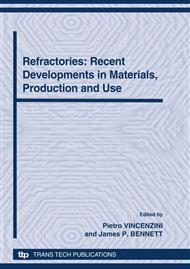p.59
p.65
p.72
p.82
p.91
p.102
p.108
p.114
p.130
Novel Refractory Development for Synthetic Rutile Manufacture via the Becher Process
Abstract:
Australia is fortunate in that it has ~80,760 kt (Ti equivalent) representing 15% of the world’s titanium resources in the form of ilmenite, rutile, anatase and leucoxene. Although of late the annual quantity of mined material has reduced due to the global financial situation, the average amount of material mined was of the order of 700 kt (Ti eq). To date the most common process used for beneficiating the ilmenite in Australia has been the Becher process to produce synthetic rutile of the order of 92-96% TiO2. Due to the nature of the mineralogy of the deposits, a very small amount of naturally occurring radioactive materials (mainly thorium) is present which for some applications is considered unacceptable. Consequently a number of years ago the Synthetic Rutile Enhancement Process (SREP) was developed which removes the thorium contamination through the use of a boron containing mineral additive [1,2,3], which complexes the radioactive material during the reduction process. Unfortunately the consequences of this reaction is the build up of a flux-like material on the walls of the rotary kilns leading to significantly reduced throughput and even significant refractory loss. The aim of this paper is therefore to describe the development of a novel refractory castable system utilising the in-situ formation of aluminium titanate which in combination with matrix chemistry control and thermo-mechanical property design, greatly inhibited the adhesion of process flux on the refractory walls. The development strategy and subsequent history from simulated laboratory testing and early small scale trials up to the performance of the novel refractory in a fully lined kiln operating over a number of years will be highlighted.
Info:
Periodical:
Pages:
91-101
Citation:
Online since:
October 2010
Authors:
Price:
Сopyright:
© 2010 Trans Tech Publications Ltd. All Rights Reserved
Share:
Citation:


